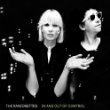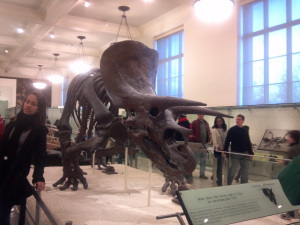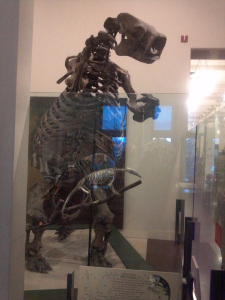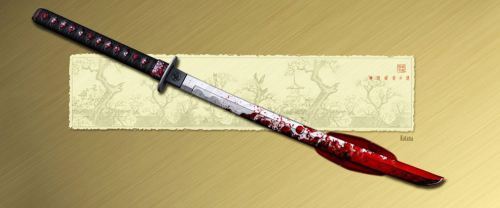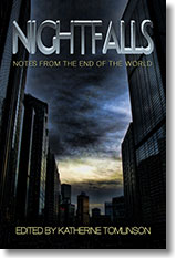Thomas Pluck's Blog, page 53
November 28, 2012
Bang! by the Raveonettes
The song in my head this week is Bang! by the Raveonettes. Like Metric, who I spoke about a while back, they’re a rock band with a female vocalist who pump out tunes I can’t get enough of. Their album In and Out of Control (link below) is great listening, as are their numerous other albums and EPs.
The Raveonettes hail from Copenhagen, a city I admired very much when I toured it with my friend Sonny a few years back, when he lived there. I’ve wanted to return, and seeing them perform live would be a great treat.
Tagged: Music, Raveonettes, Song in my Head This Week



November 27, 2012
Must You Finish a Book to Have an Opinion on it?
The excellent Mysterious Matters blog this week talks about the 50/100 page rule. That’s the number of pages that a reader will read, waiting for a book to “grab” them. Of course, some throw the book down on page ten, and others must finish it, either because “hope springs eternal,” as Agatho at MM says, or because of a neurosis. I used to compulsively finish the book. I remember the first one I quit that I actively disliked, a bio of Houdini that concentrated on his Oedipal complex rather than his act, and seemed indignant that escape artists hide keys and use trickery instead of superhuman powers. I loathed that book. But I gave it well over 100 pages, and I damn sure wrote an Amazon review excoriating it.
If that were my book and the reviewer slammed it, I’ll be honest, it would annoy me. I wouldn’t go on a tantrum and rend my garments and call attention to it, but I would likely be upset about it.
And I would be wrong.
You see, the reader owes me nothing. They have bought my book, and I am thankful. They do not owe me a review, good or bad. They do not owe me a ‘like’ or a retweet, or word of mouth. Of course, if they like the book, I would be exponentially appreciative if they told their friends about it, or reviewed it. But they don’t owe it. They don’t owe me anything.
I owe them.
You earn the reader with every line. Now, some readers skim; I try to write like Elmore Leonard said, and skip what most readers skim. (I stand corrected- Harry Crews said this, and Mr. Leonard repeated it. –ed.) We can justify it all we like, when we lose a reader. They had hemorrhoids, they have bad taste, they were tweeting and not paying attention. But in the end, we can’t really blame them. We have to do our best to write the best book we can, and if a reader doesn’t like it, they have the right to say so. Their “didn’t finish it, it was boring, it sucked” is just as valid as the equally vague “OMG I loved this book, I finished it in one sitting.” It doesn’t say why the book’s so great. We don’t even know if they paid much attention. But we don’t complain about these reviews, even if finishing the book in one sitting is unlikely because of the length.
We don’t like those “didn’t finish” reviews, but they’re the equivalent of walking out of the theater. They didn’t like the movie. They paid for their ticket and decided the next hour or two of their lives were better spent elsewhere. The same with a book. They walked out. Their review may not hold the same weight as Pauline Kael’s, but it’s as honest as any. Move on, and let it go.
But to quote the Dude, that’s just like my opinion, man. And the bad review is theirs.
What’s yours? Do you think it is okay to review a book you couldn’t bear to finish? Would you say page 50 or 100 was enough? Ten pages? One?
Tagged: Amazon, bad reviews, Books, Internet, readers, reading, reviewers, Writing



November 26, 2012
Tommy Salami in Spaaaace!
The Museum of National History is one of my favorite places. I first went as a kid and remember what every kid does- the enormous dinosaur skeletons, the huge diorama of the whale and the squid, the windows upon windows looking upon the Ark’s worth of critters that Teddy Roosevelt shot. Much of it is the same today, only modernized. It is still a temple to science, as it should be.
My favorite hangout is the Hayden Planetarium, where they have a spectacular display outside to explain the incredible scales of the universe. From quarks and protons to the greatest stars, these spheres put the universe in perspective. And sometimes, you need a little perspective.

They don’t have a T. Rex, or we missed it. But they did have full skeletons of cave bears and other huge mammals like this one. I think it was a sloth.
They have a lot of other fun stuff, like an excellent exhibit of human ancestors. Yes, the dioramas may be modernized but they still feel weird, as you stare at the oddly pale hominids in unlikely states of undress. I’m unsure what that teaches us, other than that Neanderthal women had nice tits. The skulls and skeletons, and the straightforward explanation of our complicated ancestry, our knowledge of which is still evolving, was the star of the exhibit.
Between this and the Egyptian collection at the Metropolitan Museum of Art, my imagination was piqued as a child and I still love wandering these museums and drinking in history and the discoveries we have made about the universe.
And just for fun you can put yourself in different videos. Exploring the ocean, or on the sadly dust-binned space shuttle:
Tagged: Dinosaurs, History, Museums, New York City, Science, Space



November 25, 2012
Oh, Sandy! A Benefit for Victims of Hurricane Sandy

My good friend and hilarious writer Lynn Beighley is seeking submissions for her anthology OH SANDY! An Anthology of Humor for a Serious Purpose, to benefit victims of the super storm. All proceeds will go to food banks local to those affected by the storm.
Submission Guidelines and Deadline:
Until December 31, we are accepting submissions of humorous fiction and non-fiction—up to 3000 words—that are about experiencing a disaster, surviving a hurricane, or living in New Jersey (a lot can be said humorously about New Jersey without being cruel) to publish in OH SANDY! An Anthology of Humor for a Serious Purpose. Submissions not accepted for the anthology may still be posted on this website with your approval.
My gears are turning, to bring some humor to this tragedy, and I hope you’ll consider joining the cause. Either by writing a story and submitting it to her, or by purchasing the book. Or donating to the charities listed on the website.
Tagged: Anthologies, charity, Hurricane Sandy, Lynn Beighley, New Jersey, New York City, Submissions Calls



November 24, 2012
Frank Sinatra in a Blender
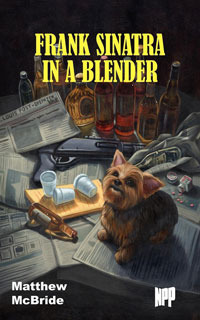
I originally reviewed this book in 2011 when it was published in e-book form. I loved it then, and I love it now that New Pulp Press has published it in a snazzy paperback. So here’s an all-new review of a book that was in my top 5 for 2011 and should be on your list, right now:
Nick Valentine is a walking liquor store who walks both sides of the law. His only code is don’t mess with his little dog Frank, and keep the drinks coming. He is one of the funniest characters I’ve ever read, the bastard son of Bukowski and Hunter S. Thompson.
A title like this can be a bait & switch. When I was given the Canadian poet Crad Kilodney’s collection entitled “Lightning Struck My Dick,” I was sorely disappointed that said event never occurred within. McBride delivers the goods, and then some.
A bank job goes horribly wrong, and the Chief of Police asks Nick to put his ear to the street. Nick’s father was a cop and well, Nick isn’t, but he tries to be the good son… or a good son of a bitch. He gets tangled up with some very unsavory locals, some of whom are the closest he’s got to friends. McBride paints his colorful characters in moral shades of gray, but their motives are unquestionable, purely driven by character and human nature. English Sid and No-Nuts are two of the greatest villains I’ve read in a long while.
Nick’s only superpower is his mighty tolerance for alcohol, and his proclivity for inserting violence in the uncomfortable pauses where normal people are thinking about the consequences. There’s also an ex-Amish policeman who rings true- not played for laughs. It’s got plenty of heart and humanity in between the over the top laughs, brutality and Elmore Leonard-style double crosses.
No, despite the title and Nick’s fondness for drink, this is a character-driven crime thriller that makes me wish there was a whole damn series already written, so I could spend a week reading them. The only bad thing about this book is having to wait for the next one.
There’s a next one, ain’t there, Matt?
Get to it, or I’ll put YOU in a blender.
Tagged: Books, Crime, Frank Sinatra in a Blender, Matthew McBride, Reviews



November 23, 2012
Belly up to the Bar with Chad Eagleton
Chad Eagleton is a two-time finalist of Watery Grave International, and his story “Ghostman on Third” was nominated for a Spinetingler Award. His work has appeared in Discount Noir, Crime Factory: The First Shift, and Beat to a Pulp, and he wrote the excellent heist tale “Go Away” for Protectors: Stories to Benefit PROTECT. He’s also very likely the most knowledgeable authority on author Shane Stevens, best known for By Reason of Insanity.
 TP: Hi Chad, welcome to Belly Up to the Bar. What’ll you drink?
TP: Hi Chad, welcome to Belly Up to the Bar. What’ll you drink?
 CE: I don’t really drink that much. When I do I tend to stick to beer. I’m partial to Franziskaner, Peroni, or Red Stripe. Though there’s a local brewery that makes a wheat beer that’s pretty fantastic on tap and served with a fresh slice of orange. Hard alcohol and I had a falling out years ago during my misspent youth. We’ve never gotten along since, except for a brief fling at a friend’s wedding.
CE: I don’t really drink that much. When I do I tend to stick to beer. I’m partial to Franziskaner, Peroni, or Red Stripe. Though there’s a local brewery that makes a wheat beer that’s pretty fantastic on tap and served with a fresh slice of orange. Hard alcohol and I had a falling out years ago during my misspent youth. We’ve never gotten along since, except for a brief fling at a friend’s wedding.
 TP: Good taste in beer, sir. You work at a university, don’t you? No better reason to drink. It’s almost a given, that anyone involved in higher education will have a drink after work, like journalists and theater people. What is it like seeing fresh-faced students leave home for the first time, and how does it inform your writing?
TP: Good taste in beer, sir. You work at a university, don’t you? No better reason to drink. It’s almost a given, that anyone involved in higher education will have a drink after work, like journalists and theater people. What is it like seeing fresh-faced students leave home for the first time, and how does it inform your writing?
 CE: It’s both wonderful and terrible. Working in The Dean of Students Office, I see young adults at their best and at their worst. I see students come to campus and flourish. They open up their entire world to new people, new ideas, and new experiences. They travel abroad for the first time. They start clubs and put on events. They initiate great acts of widespread charity.
CE: It’s both wonderful and terrible. Working in The Dean of Students Office, I see young adults at their best and at their worst. I see students come to campus and flourish. They open up their entire world to new people, new ideas, and new experiences. They travel abroad for the first time. They start clubs and put on events. They initiate great acts of widespread charity.
I also see the students who flounder. They get lost on such a large campus. They get caught up in partying and drinking. They have a mental breakdown from the stress and the loneliness. They lose a parent while trying to prepare for finals. They go to a party and a stranger sexually assaults them.
It’s the best job I’ve ever had and it’s the worst.
 TP: I’ve always felt that the transition from high school to college, employment or vocational training is rather abrupt. In school, you may or may not be nurtured, but you are punished for self-destructive behavior, like skipping class. Then suddenly you’re free, and there are consequences. You’re expected to have been taught life skills, when that is becoming increasingly rare. It’s incredibly fatalistic, for a country that when polled, doesn’t believe in evolution, but does believe in “survival of the fittest,” or at least in blaming you for how you were raised. We sacrifice our children on the altar of this self-sufficient ideology, this myth we’ve created. It’s kind of like bullying, or the cycle of corporal punishment- Hell was good enough for me, now it’s your turn. Andrew Vachss made us aware of the cycle of child abuse creating violent criminals; do you think crime writers like us can do the same for emotional abuse and bullying?
TP: I’ve always felt that the transition from high school to college, employment or vocational training is rather abrupt. In school, you may or may not be nurtured, but you are punished for self-destructive behavior, like skipping class. Then suddenly you’re free, and there are consequences. You’re expected to have been taught life skills, when that is becoming increasingly rare. It’s incredibly fatalistic, for a country that when polled, doesn’t believe in evolution, but does believe in “survival of the fittest,” or at least in blaming you for how you were raised. We sacrifice our children on the altar of this self-sufficient ideology, this myth we’ve created. It’s kind of like bullying, or the cycle of corporal punishment- Hell was good enough for me, now it’s your turn. Andrew Vachss made us aware of the cycle of child abuse creating violent criminals; do you think crime writers like us can do the same for emotional abuse and bullying?
 CE: In general, a lot of people tend to be myopic when it comes to others. That makes emotional abuse and bullying tough to tackle. Those scars are scars on the inside, so they’re not readily visibly to the naked eye. And it’s part and parcel to that ridiculous self-sufficient ideology that’s so prevalent in our society. Too often emotional abuse is dismissed as just toughening the person up, preparing them for the harsh world out there. Some have the foolish idea that the responsibilities of a parent extend only to food, clothing, and shelter. So they neglect emotional growth when that’s what determines how we interact and treat each other. Then there’s my all-time favorite response, just get over it. Yeah, just get over it has worked for no one ever. The people who say just get over it? They’re really just speaking from their own hurt place. What they’re saying is, “No one helped me, why should anyone help you?” And they haven’t even gotten over it themselves. They’ve just buried it better.
CE: In general, a lot of people tend to be myopic when it comes to others. That makes emotional abuse and bullying tough to tackle. Those scars are scars on the inside, so they’re not readily visibly to the naked eye. And it’s part and parcel to that ridiculous self-sufficient ideology that’s so prevalent in our society. Too often emotional abuse is dismissed as just toughening the person up, preparing them for the harsh world out there. Some have the foolish idea that the responsibilities of a parent extend only to food, clothing, and shelter. So they neglect emotional growth when that’s what determines how we interact and treat each other. Then there’s my all-time favorite response, just get over it. Yeah, just get over it has worked for no one ever. The people who say just get over it? They’re really just speaking from their own hurt place. What they’re saying is, “No one helped me, why should anyone help you?” And they haven’t even gotten over it themselves. They’ve just buried it better.
I mean, think about it like swimming. How many people do you know who actually learned to swim by being tossed in the deep end? I can’t think of any. The ones I know are terrified of swimming and the ones who say they ain’t, well, I’ve never actually seen them swim.
And when it comes to bullying, a lot of people have trouble understanding that it’s harder for the bullied now. In my high school, there was one particular hallway I avoided and I especially loathed riding the bus. I mean, the bus was hell. Absolute hell. Even after I finally had enough, punched one of my bullies in the face and tried to choke him out, I still hated to see that yellow monster top the hill. But I had the luxury of escape. I could avoid the hallway. I could not ride the bus. I could go home and not suffer the same torments I suffered at school. Kids now don’t have that same luxury. Their lives are different. They’re on Facebook and Twitter; they have e-mail accounts and cell phones. Bullies have 24-7 access to their headspace. That’s fucking rough. I don’t know if I could have taken that.
As writers though, we can dig in to those places, show that headspace, and what’s going on behind closed doors. I think it’s our responsibility, not just as artists, but as human beings. We are all in this life thing together, man. That doesn’t mean we need to meet regularly and hold hands and sing kumbaya. But your wellbeing impacts my wellbeing. And that guy over there? His wellbeing affects my wellbeing and your wellbeing. I mean, you know what, man, fuck getting kicked into the Spartan pit. You know what happened to the Spartiate class? They don’t exist anymore.
 TP: I had my share of bullying back then, and I used the Internet to escape. Now it’s a deathtrap. But I agree that writers should have some sort of motive in regards to the rest of humanity, even if it means making people happy from a good read. One writer you introduced me to was Shane Stevens, who is best known for writing the first serial killer novel, By Reason of Insanity. You’re a scholar of his work. I’m fascinated by your research into his career. He began with the pulps, wrote social novels set in Harlem, P.I. novels set in New Jersey… his prolific and varied output is an inspiration. Give us a portrait of the man and his work, and why you chose to research it.
TP: I had my share of bullying back then, and I used the Internet to escape. Now it’s a deathtrap. But I agree that writers should have some sort of motive in regards to the rest of humanity, even if it means making people happy from a good read. One writer you introduced me to was Shane Stevens, who is best known for writing the first serial killer novel, By Reason of Insanity. You’re a scholar of his work. I’m fascinated by your research into his career. He began with the pulps, wrote social novels set in Harlem, P.I. novels set in New Jersey… his prolific and varied output is an inspiration. Give us a portrait of the man and his work, and why you chose to research it.
 CE: My obsession with Shane Stevens started when I got The Dark Half for Christmas. King’s novel is a supernatural thriller, but he included these excerpts from protagonist Thad Beaumont’s pseudonymous crime novels. My experience with crime fiction was pretty limited then, so those really jumped out at me. I liked reading King’s book, but I wanted more Alexis Machine.
CE: My obsession with Shane Stevens started when I got The Dark Half for Christmas. King’s novel is a supernatural thriller, but he included these excerpts from protagonist Thad Beaumont’s pseudonymous crime novels. My experience with crime fiction was pretty limited then, so those really jumped out at me. I liked reading King’s book, but I wanted more Alexis Machine.
In his afterward, King reveals his intentional nod to Shane Stevens’ novel Dead City. He praises Stevens’ books, writing: “These works, where the so-called ‘criminal mind’ and a condition of irredeemable psychosis interweave to create their own closed system of perfect evil, are three of the finest novels ever written about the dark side of the American Dream.”
Whoa. That was some heavy shit for a 13-year-old, but, man, I wanted to read those.
While I didn’t have much luck then—you have to remember this was before everyone had an internet connection and Amazon didn’t exist—I never forgot Alexis Machine and I never forgot Shane Stevens. Over time, I tracked down the six novels he wrote under his own name: Go Down Dead, Way Uptown In Another World, Dead City, The Rat Pack, By Reason of Insanity, and The Anvil Chorus. Later I put together that he wrote two P.I. novels under a pseudonym, found them and read them. All of Stevens’ work floored me. Here was the sort of crime fiction I wanted to write: a good story with a social conscience; work that’s gritty and dark, but not squalor porn; fiction that shines a light in the darkness, instead of breaking the few bulbs still burning—too many writers revel in writing about aberrant behavior as if that proves they’re some sort of hard ass.
Then a couple years ago, I sat down to write about his work for Forgotten Books and realized I knew virtually nothing about Shane Stevens the man. Hell, I didn’t even know what he looked like. I tried Googling him and came up with squat. What you see in his Wikipedia entry is the extent of info that’s readily available. That intrigued me. So, I started researching and began piecing together a portrait of one of the most mysterious men in crime fiction. The most Stevens every talked about himself was in his Contemporary Authors entry when he wrote, “I never give interviews, stay in shadow, travel by night. I don’t associate with writers, don’t do book reviews, don’t play politics or give advice. I try not to hurt anyone. I go where I want and write what I want.”
 TP: I’ve picked up two of Stevens’ books, Anvil Chorus and By Reason of Insanity. Almost all his work is out of print, sadly. Like another author I know we both admire, Manly Wade Wellman. He’s easily described as Weird Appalachia. I’d compare him to Lovecraft, but despite writing about a region expected to be racist, he manages to avoid Lovecraft’s sickening xenophobia, intentionally or not. I just finished John the Balladeer, and found some of the Silver John novels, about the troubadour with the silver-strung guitar encountering human evil and the pre-human unknown, and what impresses me most is his writing, not just his fabulous imagination. You can’t skim him, and there’s no point- he wastes nary a word. What brought you to him, and what can you say that might lure him some more readers?
TP: I’ve picked up two of Stevens’ books, Anvil Chorus and By Reason of Insanity. Almost all his work is out of print, sadly. Like another author I know we both admire, Manly Wade Wellman. He’s easily described as Weird Appalachia. I’d compare him to Lovecraft, but despite writing about a region expected to be racist, he manages to avoid Lovecraft’s sickening xenophobia, intentionally or not. I just finished John the Balladeer, and found some of the Silver John novels, about the troubadour with the silver-strung guitar encountering human evil and the pre-human unknown, and what impresses me most is his writing, not just his fabulous imagination. You can’t skim him, and there’s no point- he wastes nary a word. What brought you to him, and what can you say that might lure him some more readers?
 CE: I discovered Wellman through Karl Edward Wagner, who was best known for his sword and sorcery tales featuring the immortal Kane. After Wellman’s death, Wagner served as agent for his literary estate. I read a collection he edited that included a number of Wellman’s Hok The Mighty stories. Hok is a Cro-Magnon caveman adventuring at the dawn of human civilization. The stories were a lot of fun to read and, along with the overview of Wellman’s career, piqued my interest.
CE: I discovered Wellman through Karl Edward Wagner, who was best known for his sword and sorcery tales featuring the immortal Kane. After Wellman’s death, Wagner served as agent for his literary estate. I read a collection he edited that included a number of Wellman’s Hok The Mighty stories. Hok is a Cro-Magnon caveman adventuring at the dawn of human civilization. The stories were a lot of fun to read and, along with the overview of Wellman’s career, piqued my interest.
So I sought out Wellman’s other work. The man wrote a ton of stuff, across a variety of genres and did it all well (he beat Faulkner out for an award given by Ellery Queen’s readers). Two of his standouts for me are: John Thunstone, an occult detective with a sword-cane forged by a saint, and John the Balladeer/Silver John. Wellman’s work is very imaginative, he has a cleaner prose style than a lot of the old guard so he’s aged much better, and he managed to avoid the racist under/overtones that ruin so much pulp. Seriously, if someone ever released the Complete Manly Wade Wellman (which I’d gladly buy), everyone could find at least one thing in there they’d enjoy reading.
 TP: Hell, I’d buy that book. I hope someone collects it, like they did to Paul Cain’s stories recently. Let’s get the trinity of influences out of the way: books, movies, music. I know you’re a big rockabilly fan- what do you love about it?
TP: Hell, I’d buy that book. I hope someone collects it, like they did to Paul Cain’s stories recently. Let’s get the trinity of influences out of the way: books, movies, music. I know you’re a big rockabilly fan- what do you love about it?
 CE: There are so many books that have meant a lot to me, but if we stick with crime fiction, number one would be Shane Stevens. His Way Uptown In Another World is a big messy book, but it’s simply beautiful. Every now and again, I’ll grab my copy, open it and start reading. There are passages that still get me. If I owned a small press or won the lottery, I’d buy the rights and reprint it in a heartbeat.
CE: There are so many books that have meant a lot to me, but if we stick with crime fiction, number one would be Shane Stevens. His Way Uptown In Another World is a big messy book, but it’s simply beautiful. Every now and again, I’ll grab my copy, open it and start reading. There are passages that still get me. If I owned a small press or won the lottery, I’d buy the rights and reprint it in a heartbeat.
Richard Stark’s The Hunter is a perfect crime novel. The series went on far too long, but The Hunter is just stunning.
Andrew Vachss is another big influence too. He hits those same notes that Stevens does, and his work outside writing is untouchable.
James Lee Burke always gets me. He writes some stunningly beautiful prose and the humanity present in his work is unrivaled.
Movies are the same. When I was a child we lived out in the middle of nowhere. There weren’t a lot of other kids near us and my parents worked a lot, so I was mostly on my own. I watched a ton of films. I wouldn’t even know where to begin talking about those influences. If I were forced to name a couple of crime films, I’d say: Way of The Gun, Get Carter, Hard Boiled, Le Haine, Le Samourai, 25th Hour, Brick, and Memento.
Music? I listen to music constantly and listen to just about everything except for jazz. Old standbys are Tom Waits, Leonard Cohen, Johnny Cash, The Ramones, Joy Division, Howling Wolf, and Bruce Springsteen. And a lot of rockabilly.
You know, my father and I have never been particularly close. Rockabilly is one of the few things we’ve ever been able to connect on. I love both the simplicity and the energy of the style. It has that same sense of exuberant rebellion most people look to punk for. And that classic greaser look was the first time I ever remember seeing something and thinking, now that’s cool.
 TP: I’m looking forward to your anthology, Hoods, Hot Rods, and Hellcats. I played a couple early rock and rockabilly collections continuously when I wrote my story for it. The ’50s were a time of turbulent change in America, but everyone thinks it was Ozzy & Harriet. The war vets came home, and how could you keep ‘em down on the farm, after they’ve seen the world? Why did you choose to put this anthology together?
TP: I’m looking forward to your anthology, Hoods, Hot Rods, and Hellcats. I played a couple early rock and rockabilly collections continuously when I wrote my story for it. The ’50s were a time of turbulent change in America, but everyone thinks it was Ozzy & Harriet. The war vets came home, and how could you keep ‘em down on the farm, after they’ve seen the world? Why did you choose to put this anthology together?
 CE: America loves to mythologize its past and the ‘50s are no exception. That’s definitely part of it. Wanting to dispel the Leave It To Beaver idea of the decade. I’m also sick of period crime fiction populated with guys in suits and fedoras who are on their way to a jazz club. I mean, Jesus Christ, does anyone really think that describes all of America from 1930 through 1960?
CE: America loves to mythologize its past and the ‘50s are no exception. That’s definitely part of it. Wanting to dispel the Leave It To Beaver idea of the decade. I’m also sick of period crime fiction populated with guys in suits and fedoras who are on their way to a jazz club. I mean, Jesus Christ, does anyone really think that describes all of America from 1930 through 1960?
But also, it’s something I’d like to read. That’s what really excites me about the changes in publishing. It’s now possible to do projects that don’t fit into those narrowly defined and lowest-common-denominator levels of appeal. Will HHH sell a million copies? No, but who cares? It’ll rock anyway.
 TP: You’re damn right it’ll rock. Besides telling a good story, which is every writer’s duty, what do you hope to accomplish with your writing?
TP: You’re damn right it’ll rock. Besides telling a good story, which is every writer’s duty, what do you hope to accomplish with your writing?
 CE: A lot of people say a writer’s job is to be a professional liar. I disagree. Stories are how we convey information and make sense of tough things. I think a writer’s job is to tell the truth. The truth can be wrapped up in fantasy and make-believe, but it should still be the truth. That’s what I think the old writing adage “write what you know” means. What you know is the truth about your world, about your society, and about being human. That’s what I want to do—tell the truth. If I can do that while not starving, I’ll be happy.
CE: A lot of people say a writer’s job is to be a professional liar. I disagree. Stories are how we convey information and make sense of tough things. I think a writer’s job is to tell the truth. The truth can be wrapped up in fantasy and make-believe, but it should still be the truth. That’s what I think the old writing adage “write what you know” means. What you know is the truth about your world, about your society, and about being human. That’s what I want to do—tell the truth. If I can do that while not starving, I’ll be happy.
 TP: Yes, the canard about hiding the truth in a lie, or rather, a made-up story. I think that’s important. There has to be something in there that’s true, even if it’s childish. Aren’t escapist fantasies true? Some of us wish we could be Conan, or a sorceress, or in crime fiction, the big bad-ass. My guilty pleasure is Robert E. Howard. I know the pulps are glorified now, but having read all of Howard’s Conan stories, I appreciate the imagination, but acknowledge their indulgence as well. I don’t care if the President reads Conan comics, it is still a guilty pleasure. So that’s mine, what’s yours?
TP: Yes, the canard about hiding the truth in a lie, or rather, a made-up story. I think that’s important. There has to be something in there that’s true, even if it’s childish. Aren’t escapist fantasies true? Some of us wish we could be Conan, or a sorceress, or in crime fiction, the big bad-ass. My guilty pleasure is Robert E. Howard. I know the pulps are glorified now, but having read all of Howard’s Conan stories, I appreciate the imagination, but acknowledge their indulgence as well. I don’t care if the President reads Conan comics, it is still a guilty pleasure. So that’s mine, what’s yours?
 CE: Absolutely. Escape is necessary. I don’t want anyone to think I do nothing but immerse myself in slit-your-wrists realism. I have tons of guilty pleasures. I mean, I play video games, tabletop role-playing games, and watch way way too much Anime. Then there’s my big soft spot for sword and sorcery fiction. Especially the ones written just after the baby boomers discovered psychedelics. That’s when you get the really weird stuff, like: “Only Kragzan, the lone Atlantean warrior with the glass eye carved from a meteorite that bestows the ability to see into the 5th Dimension, can tame the savage army of sex-starved Amazons and turn their fury against humanity’s cruel Lizard Overlords in post-apocalyptic Manhattan!”
CE: Absolutely. Escape is necessary. I don’t want anyone to think I do nothing but immerse myself in slit-your-wrists realism. I have tons of guilty pleasures. I mean, I play video games, tabletop role-playing games, and watch way way too much Anime. Then there’s my big soft spot for sword and sorcery fiction. Especially the ones written just after the baby boomers discovered psychedelics. That’s when you get the really weird stuff, like: “Only Kragzan, the lone Atlantean warrior with the glass eye carved from a meteorite that bestows the ability to see into the 5th Dimension, can tame the savage army of sex-starved Amazons and turn their fury against humanity’s cruel Lizard Overlords in post-apocalyptic Manhattan!”
I’m also a sucker for kung-fu films. I mean there’s always been great cinema from the east, but I’ll gladly watch the crap with the terrible sound effects and the awful dubbing. Oh, man, and I’ll kill hours watching those direct to videocassette B-movies from the late 80s and early 90s. Crap like Trancers or Dollman vs. The Demonic Toys. I love those.
 TP: Please write about Kragzan. A lot of good grit is coming out of your part of the country, the Midwest, of late. Frank Bill in Indiana, Donald Ray Pollock in Ohio. What used to be dismissed as regional fiction. What was it like growing up in Indiana, and what kind of soul does your part of the country have?
TP: Please write about Kragzan. A lot of good grit is coming out of your part of the country, the Midwest, of late. Frank Bill in Indiana, Donald Ray Pollock in Ohio. What used to be dismissed as regional fiction. What was it like growing up in Indiana, and what kind of soul does your part of the country have?
 CE: Honestly, like anywhere else it was good and bad. Mix “Small Town” by John Mellencamp with Springsteen’s “My Hometown” and you’ve got what it was like to grow up in Indiana. It’s all that stuff you see in right-wing political ads: cornfields and farmers, hard work and family values, a strong sense of community. But it’s also: acres and acres of Wal-Marts that have devoured local business, poverty and close-minded ignorance, and what-the-fuck-are-you-to-me. Indiana is like the rest of the country. Conflicted. Confused.
CE: Honestly, like anywhere else it was good and bad. Mix “Small Town” by John Mellencamp with Springsteen’s “My Hometown” and you’ve got what it was like to grow up in Indiana. It’s all that stuff you see in right-wing political ads: cornfields and farmers, hard work and family values, a strong sense of community. But it’s also: acres and acres of Wal-Marts that have devoured local business, poverty and close-minded ignorance, and what-the-fuck-are-you-to-me. Indiana is like the rest of the country. Conflicted. Confused.
 TP: I think America believes its own mythology. I think American Gods by Neil Gaiman was a good book, but he barely touched the surface, because he got tied up with actual pantheons. We believe in the cowboy, the lone killer who comes to town, and our monsters are stereotypes from movies and the news. The welfare queen, the crackhead, and maybe the terrorist. Terrorists exist, but not as we imagine them. Any thoughts on that, or have I had too many beers?
TP: I think America believes its own mythology. I think American Gods by Neil Gaiman was a good book, but he barely touched the surface, because he got tied up with actual pantheons. We believe in the cowboy, the lone killer who comes to town, and our monsters are stereotypes from movies and the news. The welfare queen, the crackhead, and maybe the terrorist. Terrorists exist, but not as we imagine them. Any thoughts on that, or have I had too many beers?
 CE: Mythology was created to give comfort. Early man squatted in the caves and huddled together near the fire because they were afraid of the darkness and the beast noises in the night, the thunder crack and the lightning strike. They created gods and monsters and demons to explain their fears and all the things they didn’t understand.
CE: Mythology was created to give comfort. Early man squatted in the caves and huddled together near the fire because they were afraid of the darkness and the beast noises in the night, the thunder crack and the lightning strike. They created gods and monsters and demons to explain their fears and all the things they didn’t understand.
As human beings we hunger for continuity. To fulfill that desire, we tell ourselves the world is purposeful, that our lives can be directed by a well-thought-out plan.
We’re wrong.
The problem is too many think the alternative is to accept life as meaningless. So, instead of facing the hard truths and rising to the challenge, we choose to death-grip the easy make-believe bullshit. It’s a human thing, sure, but it’s 100% an American thing. Mythology reigns as king here and it’s to our detriment.
It’s sad because there’s another strain to the American psyche that has the potential to lead us all to a better place. We just have to give up our fantasies: 9-11 was not a global conspiracy by our government or the Bilderbergs or the Illuminati or Satanists. The past was not wonderful, the future is always better. Poor is not a choice. You will probably never be rich. You will not get that raise just because you worked hard—nothing in this world is a meritocracy. And, if there is a God, that higher being doesn’t care who you vote for.
 TP: I’m not sure the future is always better, I think Progress is another of our myths, but we certainly treat people better. I was stunned to read that the bloody 20th century was the least violent on record. Holocaust and all. That’s terrifying. Speaking of death, what’s your last meal?
TP: I’m not sure the future is always better, I think Progress is another of our myths, but we certainly treat people better. I was stunned to read that the bloody 20th century was the least violent on record. Holocaust and all. That’s terrifying. Speaking of death, what’s your last meal?
 CE: Sushi. Really really good sushi. Not the kind you buy in the grocery store or get at a buffet. The kind you don’t get to order. The kind the chef prepares for you. He sets it in front of you, you take it, you eat it and you don’t use soy sauce.
CE: Sushi. Really really good sushi. Not the kind you buy in the grocery store or get at a buffet. The kind you don’t get to order. The kind the chef prepares for you. He sets it in front of you, you take it, you eat it and you don’t use soy sauce.
 TP: Omakase. Go ahead, say “Gesundheit.” I would. Thanks for dropping by, Chad. I enjoyed chatting with you. If you come to New York, we’ll go to Masa and have a master make us sushi. But one last thing. Other than Hoods, Hot Rods, and Hell Cats, what are you working on?
TP: Omakase. Go ahead, say “Gesundheit.” I would. Thanks for dropping by, Chad. I enjoyed chatting with you. If you come to New York, we’ll go to Masa and have a master make us sushi. But one last thing. Other than Hoods, Hot Rods, and Hell Cats, what are you working on?
 CE: There’s a lot coming down the pipe: In The Clear, Black Fields of Night for Beat To A Pulp, “The Girl With The David Bowie Eyes” for Paul Brazil’s next Drunk on the Moon collection, “Blood on the Milky Way” for Andrez Bergen’s Tobacco-Stained Sky.
CE: There’s a lot coming down the pipe: In The Clear, Black Fields of Night for Beat To A Pulp, “The Girl With The David Bowie Eyes” for Paul Brazil’s next Drunk on the Moon collection, “Blood on the Milky Way” for Andrez Bergen’s Tobacco-Stained Sky.
More immediately, and more personally, however, is Hoods, Hot Rods, and Hellcats. The project’s proven to be a lot tougher to finalize than I thought it would be, though everyone involved has been incredibly patient. I think people will be pleased with the final book. The cover is phenomenal with artwork by Skott Kilander and layout by Brian Roe of RSquared Comics. The stories are topnotch. There’s an introduction by someone I’m a big fan of. And it’s been fact-checked to avoid period goofs.
Then, my main focus will be the Stevens book. Like I mentioned earlier, I’ve been researching him for a while. I do, honestly, probably know more about Shane Stevens than anyone else, except for Shane Stevens. I’ve got a pretty detailed timeline of his life. I’ve spoken to friends, exes, and colleges. I’ve got a number of his letters, and I’ve tracked down about 15 photographs. I’ve got an evolving bibliography of everything he’s written that goes far beyond the 8 novels—I’ve probably read more of his work than anyone else, except for his mother. I don’t know if a publisher will ever touch it, but if not I’ll put that out myself too. If nothing else, I hope it leads to a widespread reprinting of his catalogue. And, assuming people are actually interested, I’ve tracked down his personal papers, so…
Other than that, I just want to say thanks for having me, man. You’re one of the good ones, Thomas Pluck. It’s been an honor.
 TP: Glad to have you. I’ll be looking for those books.
TP: Glad to have you. I’ll be looking for those books.
Tagged: Belly up to the Bar, Chad Eagleton, Interviews, Shane Stevens, Writers



November 22, 2012
I Thank You
First: to my Firecracker, my family, my friends. Thank you.
Then I would like to give thanks to everyone who bought PROTECTORS: Stories to Benefit PROTECT and supported the only lobby which fights the physical, sexual and emotional abuse of children exclusively. Take a look at what Protect has done:
Maybe you bought the book because 100% of the proceeds go to PROTECT.
Or maybe you bought it for the exclusive first three chapters of Ken Bruen’s upcoming novel, or for the excerpt from the book Charlie Stella’s working on. Or for the DC street tale from George Pelecanos, novelist and writer for Treme and The Wire, the Hap Collins story by Joe Lansdale, the tale by World Fantasy Award winner Charles de Lint, the Edgar finalist from Chet Williamson, the thriller by Michael A. Black, the classic by Andrew Vachss, the WGI winner by Ian Ayris, the Gus Dury tale by Tony Black, the all-new Cash Laramie tale by Edward A. Grainger, the stories by Bill Cameron, Roxane Gay, Jane Hammons, Gary Lovisi and Richard Prosch.
Or it could be the NEW fiction from Patti Abbott, Ray Banks, Nigel Bird, R. Thomas Brown, Jen Conley, Wayne D. Dundee, Chad Eagleton, Les Edgerton, Andrew Fader, Matthew C. Funk, Glenn G. Gray, Amber Keller, Frank Larnerd, Mike Miner, Zak Mucha, Dan O’Shea, Keith Rawson, James Reasoner, Todd Robinson, Johnny Shaw, Gerald So, Josh Stallings, Steve Weddle, and Dave White.
Or because it’s the only book in which my Weird Tale of haunted Appalachia, where two boys tangle with moonshiners, wendigos and demon dogs, and meet hoodoo folksinger Blind Joe Death, will be available.
For whatever reason you bought the book, thank you. You’ve made it a resounding success that will continue to help fund PROTECT’s good work for the decade it remains in print.
And if you can’t support us- you can help by clicking the ‘Share’ button. Spreading the word helps more than you know. But do it tomorrow. Today, spend some time being thankful with those you love, and think of how to give others something to be thankful for.
Wishing you and yours a happy Thanksgiving, and many reasons to give thanks all year.
Thank you.
Thomas Pluck
The Protectors anthology is available here:
Trade Paperback:
Watchung Booksellers
Createspace
Amazon
Barnes & Noble
Powell’s Books
Indiebound
E-Book:
Amazon Kindle
Amazon Kindle UK
Apple iPad
Smashwords
Barnes & Noble Nook
Kobo Bookstore
Smashwords (all formats, and read the book in your web browser)
Tagged: Books, PROTECT, Protectors Anthology, Thanksgiving, Writers



November 21, 2012
The Next Big Thing: BLADE OF DISHONOR
I got tagged by Ed Kurtz, author of Bleed, Control and others, to join in The Next Big Thing blog tour. Normally I don’t jump in for these things but he’s a good guy and it’s an easy way to talk about works in progress, and let readers know about other writers they might enjoy.
1) What is the working title of your next book?
Blade of Dishonor, a novella for Beat to a Pulp. (I’ve mentioned Bury the Hatchet a lot on the blog, and it is still in progress, but this will be done first.)
2) Where did the idea come from?
David Cranmer asked if I’d be interested in writing about an MMA fighter tussling with ninjas over a stolen sword. How could I say no to that? David published my mixed martial arts fighter tale “A Glutton for Punishment,” and I grew up on ’80s ninja movies and the Shogun Assassin “baby cart” samurai films. It is set in the present day, but the action begins in World War 2. I enjoy writing this so much that there may be a prequel written in the era of feudal Japan.
3) What genre does your book fall under?
Adventure. Pulp is not a genre and “men’s adventure” paperback originals aren’t either, really. Adventure covers it, with a little War thrown in.
4) What is the one-sentence synopsis of your book?
Mixed martial arts fighter Reeves comes home from Iraq to help his wheelchair-bound grandfather run his Army-Navy store, and becomes embroiled in a centuries-old battle between ninja and samurai over a priceless and powerful Japanese sword.
5) What actors would you choose to play the part of your characters?
Reeves, the MMA fighter, would be played by Joel Edgerton. He was in Warrior, he played a fighter and made it look real. Plus he’s got those sad eyes that women like, and looks like someone went over him with coarse grit sandpaper. My kind of hero.
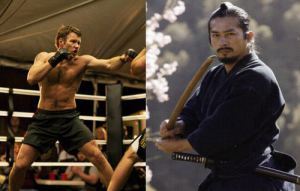
Joel Edgerton vs. Hiroyuki Sanada
His grandfather Butch, the wheelchair-bound war vet would be played by Ed Asner. He’s big, old, and angry as hell. Better known for comedy, but the man is a firestorm. The villain is a Japanese businessman, who could be played by Tadanobu Asano, best known for his role in Thor.
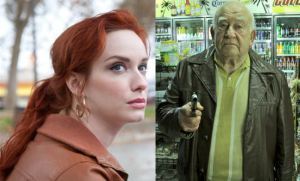
Hendricks drives and Ed is Bad-ASNER
And his brutal henchman Mikio would be a good role for Hiroyuki Sanada, who is in “Revenge” and the new Wolverine film. He has the scruffy, beat down look. Tara, the gal with the suped-up muscle car, could be Gina Carano, but Tara is an art major, not a fighter. She’d break a fired chunk of pottery over your head, not try the flying armbar. She’s more of a Christina Hendricks, tough on the inside.

She’ll be in my next story, I promise.
6) Will your book be self-published or represented by an agency?
It is a work for hire for Beat to a Pulp press.
7) How long did it take you to write the first draft?
8 weeks.
8) What other books would you compare this story to within your genre?
Action-oriented thrillers like the Jack Reacher novels by Lee Child and the Pike novels by Robert Crais, but grittier. War novels like The Short-Timers, James Brady’s The Marines of Autumn. I won’t say there’s nothing like it out there, but I haven’t read anything close. Maybe my readers can enlighten me.
9) Who or what inspired you to write this book?
My great-uncles all fought in World War 2, in Europe and the Pacific. The book is dedicated to them. They never talked in detail about the War, but their feelings were made clear. And I’ve been fascinated with Japanese culture since I was a kid. I loved Clavell’s Shogun, the Lone Wolf and Cub manga–I read all 28 volumes–Musashi, the yakuza gangster movies of Suzuki, Takashi Miike, Takeshi Kitano, and of course, the samurai films of Kurosawa and Hiroshi Inagaki, any movie with Toshiro Mifune in it.
10) What else about the book might pique the reader’s interest?
The story follows Reeves in Part 1, then his grandfather Butch Sloane, in Part 2. Butch was a commando in the Devil’s Brigade. It is meticulously researched, and while we are in the trenches for all of the story, if you look up the battles date by date, what weapons, who fought in it, and how they won, it will satisfy all but the most unforgiving. It’s fiction, after all. I took license here and there, but I put the characters into real situations. The Devil’s Brigade existed, they fought the battles in the book, and if I change history, it is to insert the lost history of a grand plan that failed. The Devils were the inspiration for Tarantino’s Inglourious Basterds, only they were even badder.
And if you enjoy mixed martial arts, I trained in them for seven years. I write them realistically. I know a pro and amateur fighters and trainers, and I write them with respect. But also show just how brutal this training translates into combat outside of the ring.
This story is as tight and intense as anything I’ve written, fast-moving and thrilling while giving you plenty to think about. With enough action for three movies, much less one.
I’m tagging five writer friends you may know about already. If you don’t, I recommend you get acquainted with them, they are fantastic. I will admit, they have all talked to me about their projects or mentioned them on social media, so I dub them not only to spark your interest, but because of my own. They haven’t let me down yet, and I want to know what irons they got in the fire.
Josh Stallings is a film editor by day, and the author of the Moses McGuire crime thrillers by night. And I mean long into the night. We shared a hotel once, and when our sleep apnea machines were not dueling into the night like two Darth Vaders arguing over a dinner check, he was tip tapping away into the small hours. And the work shows. The McGuire books, Beautiful Naked, and Dead and Out There Bad, are two excellent tales about a bad-ass Marine who survived Beirut but never really came home. He’s a strip club bouncer, muscle for hire, and when he’s not trading slugs and elbow strikes with the bad guys, he’s at war with the demons within himself. The poetry of James Crumley’s sad, elegiac prose and the rip roaring action of Robert Crais.
Lynn Beighley delivers pills of sharp and subtle humor hidden in the steak of her fiction… like she’s sneaking medicine to one of her two Bernese Mountain dogs. She cut her teeth as a tech writer, but her short stories have appeared in journals and all over the web. She brilliantly depicts our fractured modern lives, interweaving social media personae with cold splashes of reality.
Steve Weddle is the editor for Needle: A Magazine of Noir and the creator of hitman Oscar Martello. Steve often combines hardboiled grit with absurd and fatalistic humor, but is also capable of fascinating introspection, as in the story he wrote for the Protectors anthology.
Jen Conley is an editor for Shotgun Honey, and no one captures the attitude and dialogue of New Jersey like she does. Her stories have appeared in ThugLit, Protectors, Beat to a Pulp, Out of the Gutter and elsewhere. Her characters are so full of life they claw their way off the page.
Chad Eagleton is a two-time Watery Grave International finalist and Spinetingler award nominee. His socially conscious crime fiction packs a wallop. Chad has also been researching novelist Shane Stevens, who wrote the first serial killer novel and was the basis for Alex Machine in Stephen King’s The Dark Half, and also happens to be one of the most underappreciated writers of his time.
I’m eager to hear what their fierce imaginations are up to… aren’t you?
And if you want a taste of how I write Edo Period Japan, with samurai and yakuza… read “Shogun Honey,” which I wrote for Sabrina Ogden when she was at Shotgun Honey.
Tagged: Beat to a Pulp, Blade of Dishonor, Books, Chad Eagleton, Christina Hendricks, Ed Asner, Ed Kurtz, Gina Carano, Hiroyuki Sanada, Jen Conley, Joel Edgerton, Josh Stallings, Lynn Beighley, Mixed Martial Arts, Ninjas, Steve Weddle, Swords, The Next Big Thing, Todanobu Asano, World War 2, Writing



November 19, 2012
Salute These Shorts
I love short stories. Otherwise I wouldn’t write them, because they are a pain in the ass. Sure, you can get the whole idea in your head at once, but there’s no room for error. So when I read a great one, I sit in awe. Here are a few of my favorites. What are yours?
The Creature from the Cleveland Depths, by Fritz Leiber
This one felt silly when I first read it, but now that we have cell phones, ol’ Fritz is laughing in his grave.
In the Cemetery Where Al Jolson is Buried, by Amy Hempel
Amy Hempel paints pain so beautifully, without ever using fancy brushes.
The Ones Who Walk Away from Omelas, by Ursula K. LeGuin
An incredible fable that puts civilization in perspective and asks us why we can’t walk away.
The Gentle Way, by Lawrence Block (available in his collection “Enough Rope”)
Mr. Block writes damn fine short stories. This one, about an animal shelter dealing with a vandal, resonates deeply. His excellent story “See the Woman” is available online.
Placebo, by Andrew Vachss (Available in his collection “Born Bad,” and also in Protectors: Stories to Benefit PROTECT.) You can read the also-excellent “Working Roots” free here on his website.
Placebo is a pared down work of great power. Working Roots is a gritty urban fairy tale. I wish Andrew Vachss would write a novel about these kids.
Houston, Houston Do You Read? by James Tiptree, Jr. aka Alice Sheldon.
How do you end violence? The answer is simple, if unpleasant.
Speech Sounds, by Octavia Butler
The last Ms. Butler is interviewed by Charlie Rose here:
The late, great Ms. Butler captures the terror of a true apocalypse and losing the power to communicate in this gut puncher.
The Man from the South, by Roald Dahl
One of my favorite horror tales. You’ll be clutching your fingers!
The Chaser, by John Collier
One of the funniest and best short story writers, Collier is oft forgotten but has many lessons to teach writers today and many joys to bring readers for centuries hence.
The Appointment in Samarra, by Somerset Maugham
A classic bit of flash fiction.
Why I Live at the P.O., by Eudora Welty
A great picture of a family from one of its loony members.
A Good Man is Hard to Find, by Flannery O’Connor
If you don’t like this story, hit yourself in the face.
Who Goes There? by John W. Campbell
The inspiration for “The Thing,” this one is terrifying on a cellular level.
“I Have No Mouth and I Must Scream,” by Harlan Ellison. He has written a ridiculous amount of great short stories. How to choose one? This has always been the most memorable to me. A supercomputer destroys humanity in retribution for creating him–a genius who cannot truly move, feel or love– but he saves five individuals to torture for eternity. Misanthropy at its most dire. A close second is “The Paladin of the Lost Hour,” a wonderful fantasy story about a man who guards the “clock” that keeps the world from doomsday, and how he shares a moment with a veteran wracked with survivor’s guilt. The first is available in the collection of the same name, the second is in “Angry Candy.” I am also fond of the entire collection :”Deathbird Stories,” especially the title story, which retells Genesis from Satan’s–I mean “Snake’s” point of view.
Tagged: Amy Hempel, Andrew Vachss, Books, Eudora Welty, Flannery O'Connor, Fritz Leiber, Harlan Ellison, James Tiptree Jr., John Collier, John W. Campbell, Lawrence Block, Octavia Butler, reading, short stories, Somerset Maugham, Writing



November 16, 2012
Night falls out of the gutter…
First, Ryan Sayles interviewed me for Out of the Gutter. He has a column there called The Noir Affliction. Ryan is a very funny guy, though I had to throw him around a bit, and he took a few shots at me. Probably the most entertaining interview I’ve done in a while. He asks me to define noir, and I turn into the Hulk.
Read it at The Noir Affliction.
Secondly, I’m very proud to be in Katherine Tomlinson’s NIGHTFALLS anthology, out soon from Dark Valentine Press. The last day on Earth… how would you spend it? If you’re Terence Nightingale, star of my story “Acapulcolypse,” you want to take out as many human beings as possible on your own, which is a real bother when you faint at the sight of blood. The anthology benefits Para los Niños, an organization in Los Angeles that helps at-risk kids and their parents succeed in education and in life, and contains 28 more tales from the likes of Matthew Funk, Sandra Seamans, Allan Leverone, Nigel Bird, Chris Rhatigan, Col Bury, Christopher Grant, Patricia Abbott, Jimmy Callaway and Veronica Marie-Lewis Shaw.
Tagged: Allan Leverone, Books, Chris Rhatigan, Christopher Grant, Col Bury, Interviews, Jimmy Callaway, Katherine Tomlinson, Matthew Funk, Nigel Bird, Nightfalls, Noir, Out of the Gutter, Patricia Abbott, Ryan Sayles, Sandra Seamans, Science Fiction, Speculative Fiction, The Noir Affliction, Veronica Marie-Lewis Shaw, Writing



Thomas Pluck's Blog
- Thomas Pluck's profile
- 122 followers


